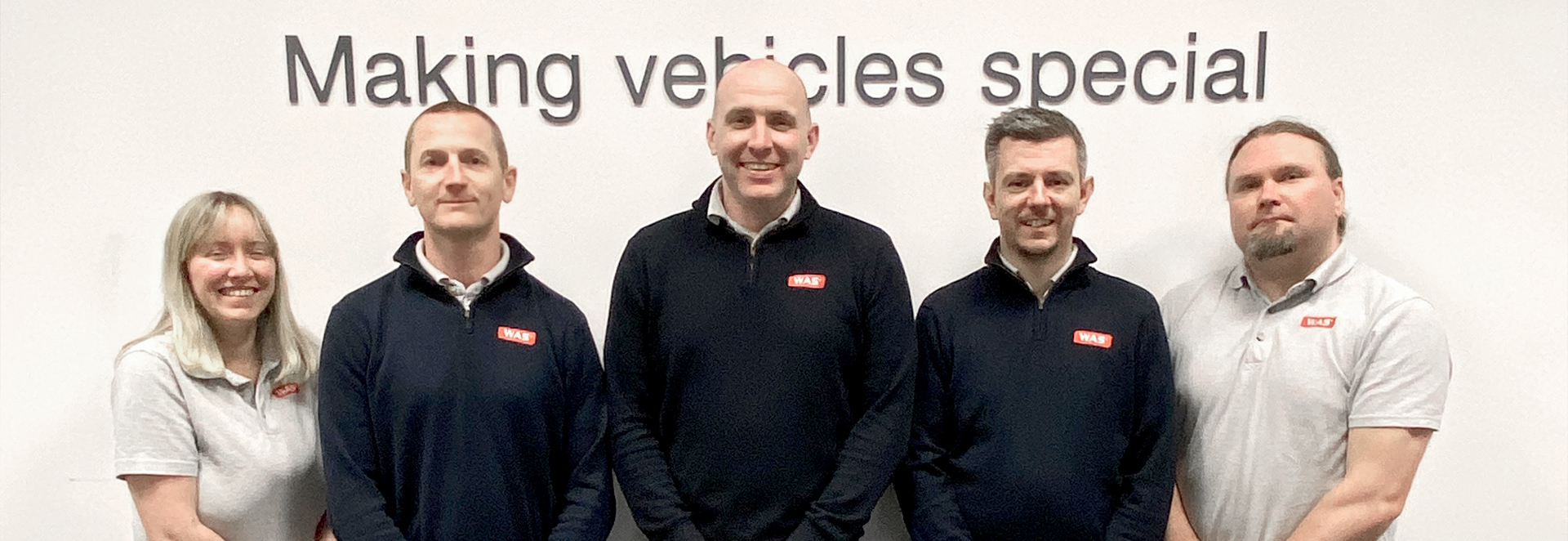


2008 was the year of the global economic crisis, which also hit the UK hard. But it was also the year that WAS UK opened its doors in the Midlands which is the central belt of Great Bri-tain. WAS UK is just north of Birmingham which is the second largest city in the UK after London with a population of over 1.1 million. WAS UK is actually located in Burton upon Trent which is best known for brewing beer and is currently home to Molston Coors Brewery.
WAS UK started modestly with two employees, Richard Skingley and Julie Skingley. The first customer was the North East Ambulance Service. Today, a great many English Natio-nal Health Services Trusts (NHS) drive WAS ambulances and rescue vehicles. Wales, Scotland and Northern Ireland also use WAS vehicles. In 15 years, the UK team have provided over 3,800 vehicles to the NHS national health system in the UK and to other private health organisations such as the Red Cross and St. John Ambulance. There are currently 1,700 of these vehicles still in warranty, which is normally 3 year term but of late has risen to 5 years. Generally the life cycle of an ambulance in the UK is 7 years.
Eight team members create something unique.
The WAS UK team is small but highly motivated. When it star-ted in 2008 with two employees, they were happy to sell 15 vehicles a year. Today, with four times the team strength, the sales figures are many times higher: a whole 400 vehicles are introduced annually, handed over to new customers, replacing ambulances coming out of service. Now it is not the case that once you have been succesful in building vehicles for an am-bulance Trust that this is then guaranteed work for many ye-ars. This is because all UK Trusts always award their contracts strictly according to public procurement tender excercises dis-tributed over 4 - 5 year frameworks. But also private charities like the British Red Cross or St. John Ambulance use tende-ring excercises for transparency and to reduce the risk of non compliance to ambulance regulations. Tom Howlett, Sales Di-rector WAS UK explains: “Responding to UK tenders takes a lot of time, we focus on ensuring our customer that WAS have all the technical capability and capacity to deliver vehicles to the correct specification and to the highest of quality standards. We also have to evidence our compliance to the EN 1789:2020 standard which is massively important in terms of safety.”
Most rescue vehicles in the UK have the stretcher on the right-hand side of the interior with two medic seats on the left. His-torically the patient stretcher is loaded into a UK vehicle using either a tail-lift or ramp, but of late the auto loading stretcher systems are becoming more popular. CCTV systems are also common on UK ambulances which record footage on all ex-ternal sides of the vehicle and also inside the patient compart-ment when a panic button is pressed. The CCTV footage is used in three ways. Firstly for insurance purposes so accident claims can be easily resolved. Secondly, the footage can be used if a medic has been attacked which can then be used as evidence to prosecute an offender. Thirdly, Police authorities request footage from the vehicle as this can be very useful evidence from a scene that they have jointly visited.
Service near at hand.
Over the years, the service partner network has grown to 30 partners throughout England, Scotland, Wales and Northern Ireland. Always in the vicinity of NHS hubs or other organisa-tions in order to achieve fast accessibility and shorter repair times. In addition, WAS UK has its own three full time service technicians who take care of warranty claims, technical sup-port and any other customer requirements. They are divided by region: one each for the South West, the Midlands and the East of England. Good organisation is everything, smiles Tom. And still looks very relaxed. Together with Managing Director Darren Sullivan, who leads the team of eight.
Highlights that are particularly fun.
if you ask Darren and Tom about special current successes, the new 3.5 t WAS 500 box vehicle based on the Fiat Ducato and MAN TGE immediately comes up in conversation. It was first presented in England two years ago. The advantages of this manoeuvrable ambulance have been recognised by St. John Ambulance (SJA), London Ambulance, East of England and Welsh Ambulance. This light weight vehicle reduces fuel consumption and emissions, this is an important step in the journey to zero emission ambulances because weight is an important factor. The 3.5 t vehicle has enough space and everything that a 5 t box vehicle also offers.
Vehicles also close to our hearts are the vehicles we produce for Neo-Natal and Paediatric transfers. These vehicles carry specialised trolley cots, baby pods, and HD patient camera to name but a few. Recently we‘ve produced these vehicles for 'South Thames Retrieval Service' operating into Evelina childrens hospital and 'Embrace', operating into Sheffield chil-drens hospital.
There are other features that are offered into this market that are unique to WAS, the soft close door system (WAS Door Assist) is a keen favorite because it reduces the amount of noise and vibration when closing doors.
WAS UK currently hold the contract to supply vehicles into the UK HART teams (Hazardous Area Response Team). An NHS rescue unit that is called out for particularly difficult missions. Among other things, also for missions in which first aid and care are required. All English Trusts have a HART team. These teams operate very specialised vehicles with specialist extrac-tion equipment. Vehicles include response vehicles, personnel carriers, ATV movers and welfare vehicles. The welfare vehicle is very useful because this carry‘s a water boiler for making tea, very important in the UK to rejuvenate staff or anyone else at a scene. A cup of of Tea is always popular across the UK!
The future should be mor environmentally friendly.
WAS Team UK also intends to make a contribution to climate protection. Darren and Tom agree: they will do everything they can to protect the climate in England from exhaust emissions with e-ambulances made by WAS. They have recently achie-ved their first success: The first fully-fledged E-ambulance on Ford base vehicle will soon be seen on UK roads. A good start for Darren and Tom.






No Comments